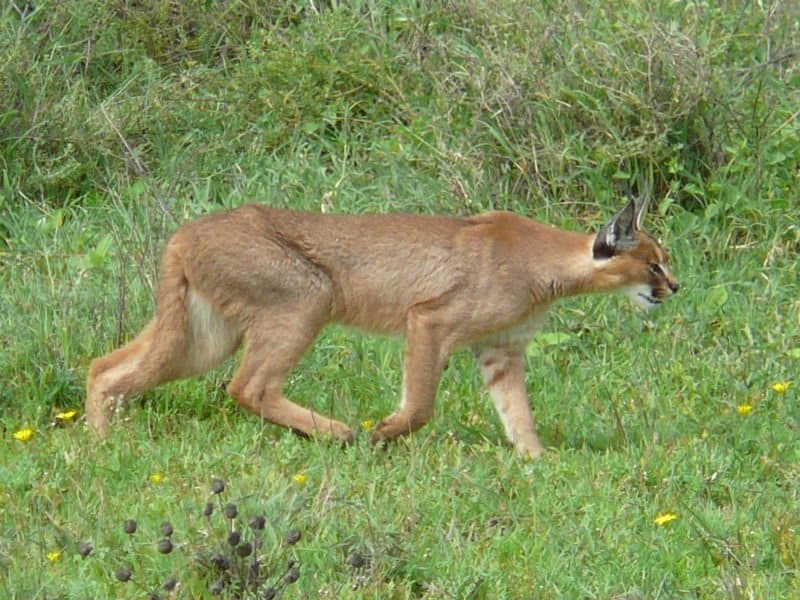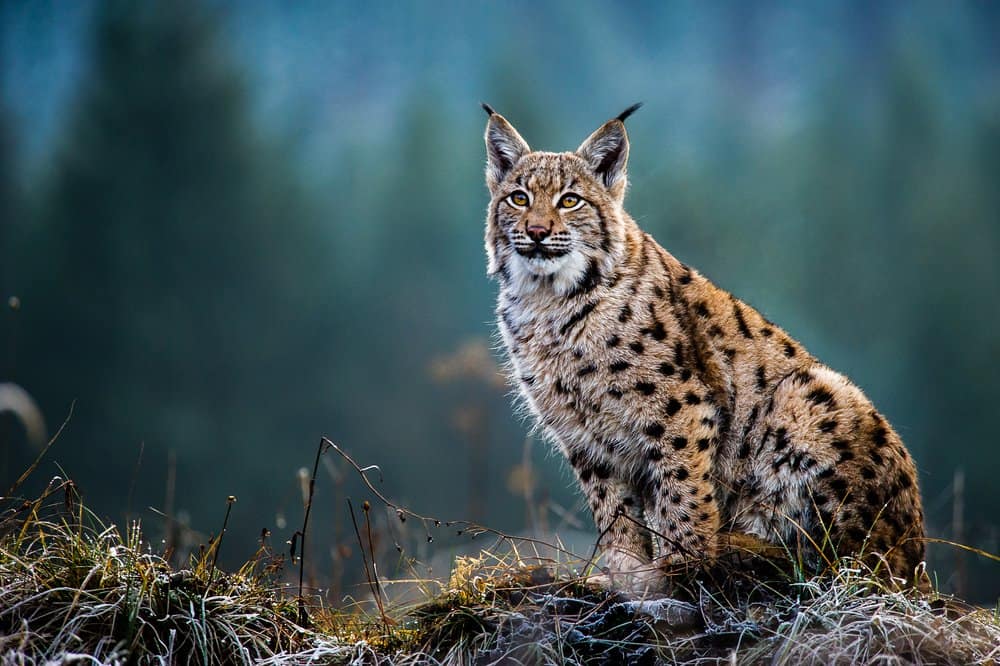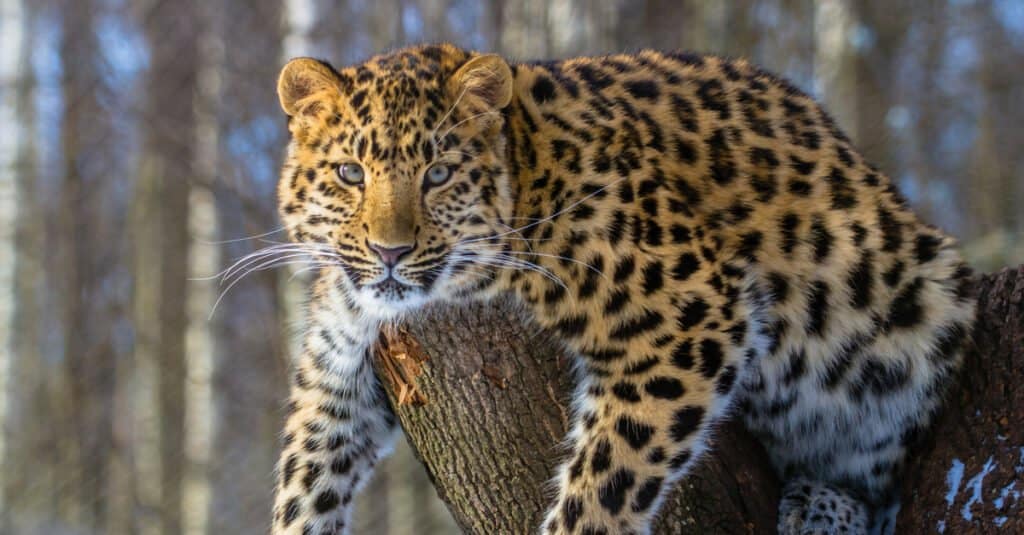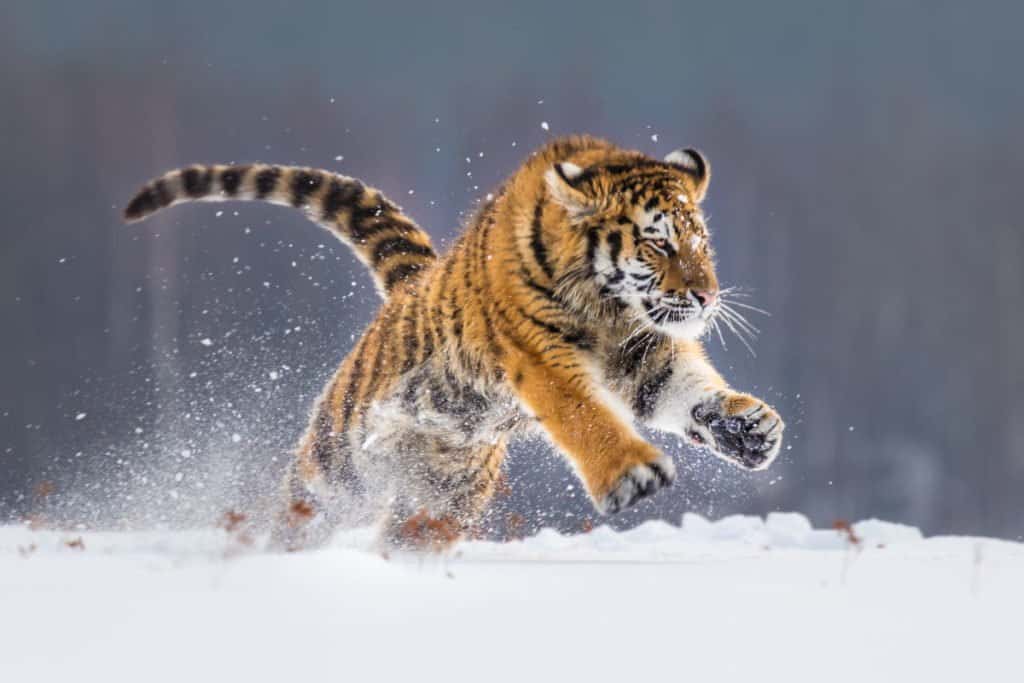Cat parents might think their kitty may have been packing on the pounds the past few years, but your chubby house cat is no match for the large cats on this list.
Let’s jump right into the ten largest and most magnificent cats in the world!
#10 Caracal (Caracal caracal)

Caracals are hunters across Africa and Southwestern Asia
©Nick and Melissa Baker / CC BY 2.5 – License
Although the caracal cat is the smallest cat on the list, it is a stealthy hunter of Africa and Southwestern Asia, not to be underestimated. This graceful and skilled climber is an opportunistic predator eating anything from birds and rodents to domestic cats and dogs.
Caracal comes from the Turkish word karakulak, meaning “black ear,” characterizing the nearly 2″ black tufts on the tips of the cat’s ears. The caracal cat is also known for its short, dense, reddish-brown and grey coat, long legs, and short face.
The caracal is a solitary animal and the largest of Africa‘s smaller wildcats. Besides Africa, caracals are found in the edge habitats of woodlands, forests, thickets, rocky hills, and plains of the Arabian and Anatolian peninsula, southwest and Central Asia, Pakistan, and Central India.
Caracal males can reach up to 40 pounds while females top out at about 34. Males can grow as tall as toddlers, at about 16-20″ at the shoulder and 34-39″ in length.
#9 Clouded Leopard (Neofelis nebulosa)
The clouded leopard or “Cloudies” are some of the most beautiful wild cats in the world. The medium-sized cats are characterized by a gorgeous coat of black shaded spots resembling clouds, sad eyes, and a stocky build.
There are two distinct subgroups of Clouded Leopards categorized for where they live.
- Neofelis nebulosa Clouded Leopards live on the mainlands of Asia, from the Himalayas Northern East Indies.
- Neofelis diardi or the Sunda clouded Leopard spends its days on Borneo and Sumatra, Indonesian islands.
Clouded Leopards are primarily arboreal, living in trees of evergreen and tropical forests, armed with many special features to aid in hunting. Their long tails help them balance, and rotating ankles aid in climbing down trees headfirst.
Cloudies can even hang from hind legs to catch their dinner.
Clouded leopards are one of the cutest wildcats, so it figures they’d also have the cutest prey, preferring mammals like:
- squirrels
- monkeys
- red pandas
- slow lorises
- porcupines
- hogs
- deer
- pangolins
Did you know the clouded Leopard has the largest canine teeth in proportion to the body size of any wild cat? They are thought to be the closest thing to a saber-tooth tiger left on earth.
Unfortunately, Clouded Leopards are one of the most poached wild cats out there, primarily for their sought-after fur coat, as well as the illegal pet trade.
Clouded Leopards are the ninth-largest cat globally, with male Clouded Leopards reaching up to 50 pounds.
#8 Eurasian Lynx (Lynx lynx)

The Eurasian lynx can grow to 92 pounds!
©Tomas Hulik ARTpoint/Shutterstock.com
The Eurasian lynx is an adaptable cat that inhabits more corners of the globe than any other wild cat, living in temperate and boreal forests of Northern, Central, and Eastern Europe, Central Asia, and Siberia. Eurasian Lynxes have even been spotted in mountainous ranges at altitudes up to 5,500 feet!
Eurasian Lynx looks similar to many wildcats with a relatively short, reddish-brown fur with spots. Since many Eurasian lynx live in colder climates, the winter months will bring a thick silky coat of silver or white.
These pretty kitties are characterized by white beards, black ear tufts, long legs, and furred paws. These big, furry feet act like snowshoes, allowing these cats to walk atop the snow instead of falling through the surface.
Eurasian Lynx is the largest of the four species within the lynx family, Standing at up to 2-1/2 feet, at 4 feet long, and with an average weight of about 50-70 pounds. However, Eurasian lynx living in Siberia can reach up to 92 pounds!
#7 Cheetah – (Acinonyx jubatus)

©Maros Bauer/Shutterstock.com
Cheetahs are among the most well-known wildcats of the world and the fastest land animal on the planet! These beauties reside primarily in Sub-Saharan Africa; however, a few Asiatic Cheetahs remain in Northern Iran.
Cheetahs can accelerate to 45 mph in 2.5 seconds and reach top speeds of 70 mph. They have flexible spines that allow them to leap up to 25 feet in a single stride! Cheetahs also have special claws that don’t ever wholly retract, acting as cleats to grip the earth and run faster.
Cheetahs are fervent carnivores who hunt animals like:
Cheetahs have big nostrils; however, they aren’t for smelling. They are for taking in oxygen while running at intense speeds.
These spotted carnivores hunt in the daylight using their keen sense of sight and stealthy stalking skills, utilizing their coarse golden coat and oval spots for camouflage.
Cheetahs are about 55 inches from head to hind, with the tail adding up to 3 feet to overall length. Male cheetahs can weigh up to 160 pounds taking 7th place on the list of the largest cats in the world.
#6 Snow Leopard (Uncia uncia)

Snow Leopard hunting for prey.
©Chris Desborough/Shutterstock.com
The Snow Leopard residing in Central Asia is also referred to as the “ghost of the mountains.” A well-earned nickname for the cat who lives in the world’s highest ranges with altitudes up to 20,000 feet.
Snow leopards currently reside in 12 countries including:
- China
- Bhutan
- Nepal
- India
- Pakistan
- Russia
- Mongolia
Snow leopards have evolved and adapted to live where oxygen is thin with their wide nasal passages and larger chest cavities. Their large chests also double as a shock absorber when leaping up to 50 feet!
Snow leopards also have more red blood cells than the average cat, allowing maximum oxygen absorption into the blood.
These majestic, floofy cats are considered vulnerable by the International Union for Conservation of Nature. It is tough to know the exact count of Snow Leopards remaining, but the estimate is currently fewer than 7000; that’s not many.
Snow leopards can grow up to 7 feet long, and adult males can weigh up to 168 pounds, making them number six on our list.
#5 Leopard (Panthera pardus)

The Amur leopard has been considered one of the rarest cats on earth.
©Dmitri Gomon/Shutterstock.com
The leopard is a graceful cat of the Panthera genus, closely related to lions, tigers, and jaguars. Leopards are found primarily in Sub-Saharan Africa, Central and Western Asia, and Southern Russia.
Living in forests, deserts, and plains, the Leopard uses its golden fur with spots called rosettes to camouflage with its surroundings, making it the perfect predator. Sadly their adaptable skin is their demise as Leopards are often hunted and killed for their coat.
The Leopard is not currently considered endangered. However, the sub-species the Amur Leopard of the Russian Far East is critically endangered, with only about 60 individual cats left in existence.
Leopards are about 8 feet long and can weigh up to 200 pounds! Now that’s a giant cat. But wait, the countdown is not over yet. There are four more cats still to come!
#4 Mountain Lion (Puma concolor)
The puma or Puma concolor is known by many as a cougar, mountain lion, or even a panther. Depending on the area, you might hear this cat described by forty different names, but the most commonly used are here.
The Most Common Names for Mountain Lions.
- Puma
- Mountain Lion
- Cougar
- Panther
- Pante
- El Leon
Mountain lions make their homes all over the Western Hemisphere and throughout the Americas.
While in Canada, you may see a cougar in the forest.
You may see a Florida panther if you visit south of Tampa.
And if you run into one of these cats in the Rocky Mountains, well, then that’s a mountain lion.
These cats are plain-looking with a golden coat and black on ears, tails, and snouts. Cougars are carnivores hunting any form of protein available, including:
Cougars that live closer to the equator are the smallest of the species then grow in size as the distance from the equator increases. Male Cougars can reach up to 9 feet long, 5 feet tall, and weigh 250 pounds!
#3 Jaguar (Panthera onca)

A
jaguar
uses its teeth to tear into its unfortunate prey
©iStock.com/Steven Anderton
This elegant cat was named “jaguar” by indigenous people of the Americas, meaning “one who kills with one leap” Although their leap is impressive at about 20 feet, their powerful bite is what makes them such an effective predator.
If you think the water is safe, think again! Jaguars can bite through turtle shells and the thick hydes of crocodilians without a hitch. These opportunistic hunters will try anything that crosses their path.
Unlike the ordinary house cat, Jaguars near wetlands and rivers like to swim, and they’re good at it!
Jaguars’ natural ranges in the Southwest U.S., Central and South America have been virtually eliminated in the past few generations. These days Jaguars are mostly confined to the rainforests of the Amazon basin and in the nearby Pantanal wetlands.
Jaguars can grow up to 7 feet long, with a height of 2-1/2 feet, and can weigh up to 290 pounds.
#2 Lion (Panthera leo)

A lion looking over its territory
©iStock.com/MaggyMeyer
This famous cat has been everywhere from storybooks to Oz, but typically lions are not cowardly at all.
Also dubbed the “king of beasts,” lions rule Sub-Saharan African grasslands and plains. These glorious cats are characterized by their manes that get darker as they get older, their bonds with others, and their roar.
Many cats are loners, except for the couple of years females spend with their cubs. However, Lions are a family that hunts together and are the only cats that roar in unison. In fact, a human can hear a lion’s roar from up to 5 miles away!
Lions are the second biggest cat globally, which isn’t surprising considering the lion is known to eat up to 80 pounds of meat at every meal!
As babies, lion cubs are only about 2 – 4 pounds, but not for long. Male lions can reach close to 600 pounds in adulthood, and females can reach up to 400!
Lions are considered a vulnerable species as only 20,000 lions remain in the world!
#1 Siberian Tiger (Panthera tigris)

©Jan Stria/Shutterstock.com
As mentioned above, many cats are loners. This category of loner cats includes the larger-than-life Siberian Tiger and probably your house cat!
Siberian Tigers are arguably the easiest big cat to recognize. Although many domestic kitties have tiger-like stripes, tigers are one of the only big cats with this cool feature.
Tigers can live anywhere where they can hide and find water and food. You can find Tigers in North Korea, China, Siberia, parts of India, the Russian Far East, and Southwest Asia to the Indonesian island of Sumatra.
These habitats include:
- Jungles
- Swamps
- Snowy pine forests
- Grasslands
- Savannas
This apex predator fears no one but the human being who is responsible for their poaching and the demise of nearly 95% of their natural habitat.
So what does the largest cat eat? Just about anything they can catch. Tigers aren’t fast, so they have to stalk, sneak and wait to pounce on unsuspecting prey, including:
- Deer
- Wild Pig
- Monkeys
- Wild boar
- Lizards
- Porcupines
A well-fed adult male tiger can grow up to 10 feet long, stand 4 feet tall, and weigh up to 680 pounds, making them the biggest cat on earth! In fact, the largest tiger ever recorded weighed 857 pounds!
Sadly, Tigers are in danger of extinction; currently, only an estimated 3000-4000 tigers remain in the wild.
We Love Cats!
Whether they share your home or you’ve only seen them on the discovery channel, cats are awesome, and they need our help.
As humans, we have the power to help these animals through adoption, donation, and conservation. Do what you can. Our lives and ecosystems would falter without all mammals.
The photo featured at the top of this post is © w1snu.com/Shutterstock.com
Thank you for reading! Have some feedback for us? Contact the AZ Animals editorial team.







